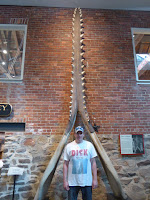 |
| Enormous macrocephalus brain |
 |
| 'Spermaceti' oil |
 |
| Flukes up! |
 |
| Diving |
 |
| Hard beak of a giant squid |
 |
| Ambergris from a sperm whale |
 |
| 'He's at home' 19th Century - Nantucket |
 |
| Scrimshaw - engraved sperm whale tooth |
 |
| Whale bone canes Nantucket Whaling Museum |
 |
| 18 foot sperm whale mandible Nantucket Whaling Musuem |
 |
| Moby Dick by Herman Melville 1851 |
 |
| 1998's Moby Dick |
 |
| The Heart of the Sea 2015 |
 |
| Svend Foyn's exploding harpoon |
 |
| 1956's Moby Dick |
 |
| Nantucket sleigh-ride |
 |
 The whales often bear scars which would suggest some struggle with oversized prey, but there is no real evidence that any squid ever got the upper hand (or tentacle). They hunt for the squid using echolocation, and the sonic blasts they emit are thought to be powerful enough that they made use them to stun prey. Humans who have swum in close proximity to the whales have talked of feelings of being probed by the powerful clicking and thumping of the echolocation, and in extreme cases, people have been temporarily paralysed, as these clicks are the loudest sound produced by any animal in the world, reaching 230 decibels (a jet engine is around 150 db to give you an idea. There is a good little film about this here.
The whales often bear scars which would suggest some struggle with oversized prey, but there is no real evidence that any squid ever got the upper hand (or tentacle). They hunt for the squid using echolocation, and the sonic blasts they emit are thought to be powerful enough that they made use them to stun prey. Humans who have swum in close proximity to the whales have talked of feelings of being probed by the powerful clicking and thumping of the echolocation, and in extreme cases, people have been temporarily paralysed, as these clicks are the loudest sound produced by any animal in the world, reaching 230 decibels (a jet engine is around 150 db to give you an idea. There is a good little film about this here. |
| Sperm whales sleeping |





No comments:
Post a Comment